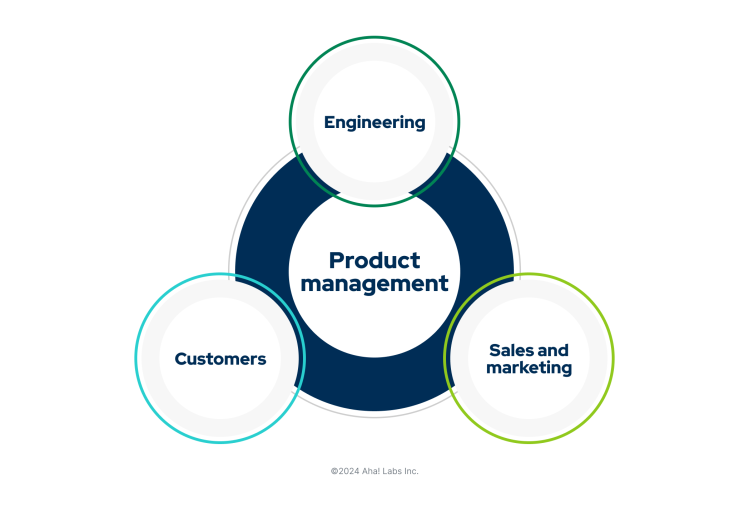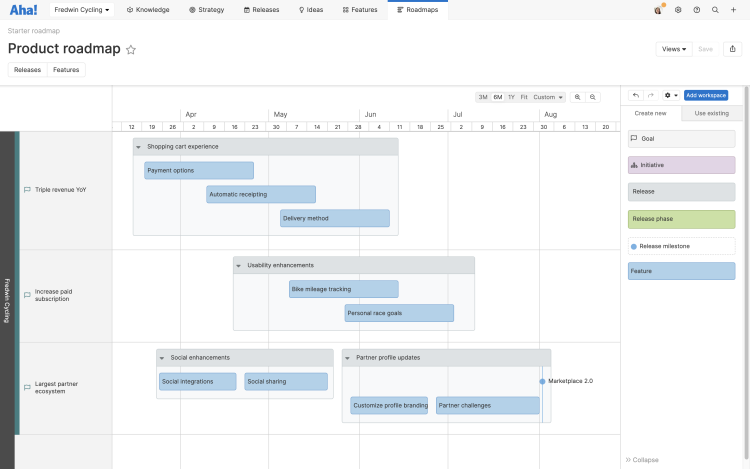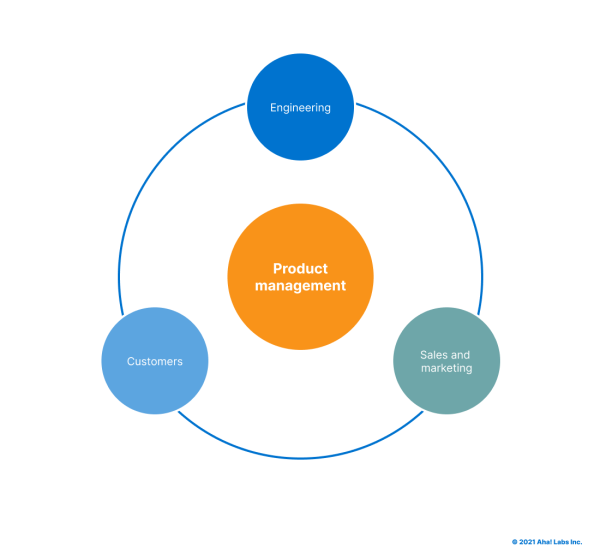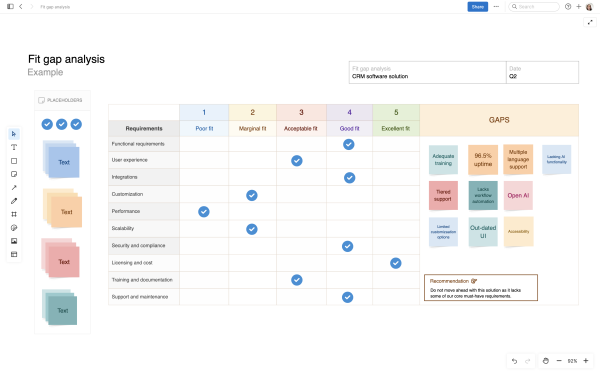What is the role of a product manager?
Last updated: June 2024
Product managers guide the success of a product and lead the team that is responsible for continuously improving it. This is an important organizational role, and especially at technology companies. It is inherently collaborative and cross-functional — encompassing responsibilities from product marketing to forecasting and profit and loss management.
Set product strategy in Aha! Roadmaps. Try it for free.
Explore the product manager's job description in detail and discover tips for excelling in this pivotal role. Jump ahead using the links below.
What does a product manager do?
A product manager defines the strategy, roadmap, and features for a product or product line based on customer needs. By analyzing the market and competition, product managers craft a product vision that delivers unique value to customers and the business. You provide the expertise needed to lead and make strategic product decisions — aligning engineering, marketing, sales, and support around this important work.

Product development is invigorating. When you feel a real sense of responsibility and commitment to your product, it can inspire you to build with conviction and help you find deep satisfaction in your work as a product manager.
Related:
Responsibilities of a product manager
Let's zero in on a product manager's core responsibilities. Although the scope of work is broad, your day-to-day responsibilities can typically be broken down into the following six areas:

1. Setting strategy
At the highest level, you are responsible for setting your product's vision and strategic direction. You need to be able to clearly articulate the business case of a given initiative or feature and then connect back to your product vision and goals. Doing so helps your team understand the "why" behind what you are building.
Strategic planning involves laying out major areas of investment so you can prioritize what matters most and achieve your product goals. You also own the product roadmap — a timeline that visualizes what you will deliver and when.
2. Evaluating ideas
Ideas fuel successful products. Product managers are responsible for crowdsourcing, developing, and curating ideas that will deliver value to customers. You own the organization's idea management process, determining which ideas should be promoted to your backlog and propelling product strategy forward.
To this end, product managers also ensure that requests are integrated into the product planning and development process. You communicate the status of ideas back to your customers, partners, and internal teammates who submitted them — closing the feedback loop.
3. Prioritizing features
Product managers are responsible for defining feature requirements and the desired user experience. You work closely with engineering on the technical specifications, and ensure that cross-functional teams have all of the information they need to deliver a complete product to market.
You prioritize features by ranking them against strategic goals and initiatives. Product managers have to make difficult trade-off decisions based on the value a new feature will deliver to your customers and the business.
At Aha! we call this value-based product development. This approach helps product teams prioritize features that create the most value for the least amount of effort. Estimating the value of new functionality is generally based on your strategic goals, the team effort required, and future customer benefit. The purpose is to look beyond daily tactical discussions and elevate your thinking to the overall worth of what you are building.
4. Defining releases
Product managers translate product strategy into planned work — defining what you will build and when you will launch it. This holds true no matter which development methodology your engineering team uses.
You are responsible for release process. You are also responsible for managing cross-functional dependencies — all of the activities required to bring new products, features, and functionality to market. This involves bridging gaps between different functions within the company and aligning key teams including marketing, sales, and customer support.
5. Building and sharing strategic roadmaps
Creating and updating your product roadmap is one of the most powerful communication tools you have as a product manager. A product roadmap visualizes how your product will achieve your business objectives and helps keep work on track.
There are many different types of roadmaps you can create depending on who you are presenting to and what you are trying to convey. Executives tend to want to know the high-level plans, while engineers and designers will need to understand the exact timing and sequencing of important work.

An example of a product roadmap built in Aha! Roadmaps that highlights strategic goals and initiatives — plus the work that will be done to accomplish them.
6. Analyzing and reporting on progress
Great product managers are laser-focused on results — for customers and for the business. You need a complete view of the team's progress towards goals to understand how your product is performing.
This is an example list of questions that help track team progress
Team efficiency
How are the most important initiatives progressing?
Which inefficiencies or blockers need to be addressed?
Are we satisfied with team velocity?
Are there any capacity issues that need to be resolved?
Product usage
What product features are the most and least used?
Where are users getting stuck and abandoning our offering?
What percentage of trials convert to paid accounts?
How many accounts are growing vs. how many are shrinking?
Answering these questions well requires deep curiosity — you need to dig into both qualitative and quantitative data. Begin by tracking team progress with sprint burndown charts and velocity reports. And you can evaluate product usage with adoption and retention reports. No matter what kind of report you select, make sure it tells an accurate story of how you are meeting your product goals.
Editor's note: Although the video below still shows core functionality within Aha! software, some of the interface might be out of date. View our knowledge base for the most updated insights into Aha! software.
Related:
Tips for new product managers
If you are just starting as a product manager or have moved into a new role, the breadth of your responsibilities can be overwhelming. To help, we developed a Product All-Star blog series where we interview seasoned product managers from around the world. We dig into their unique career pathways, discern how they stay motivated on the job, and always ask them which traits are must-haves in product management. Here are some standout tips for PMs who are looking to find success in the role:
Start with strategy
Each product decision, even early on, should be rooted in strategy. Do not jump into decision-making impulsively. Dig into existing product goals and make sure you understand what you are trying to achieve. Then, build a framework so you can visualize needs across the business.
Get to know your customers
Empathy is essential for successful product managers. Spend time understanding the problems your product solves for customers. Sit in on sales calls, make time to meet customers, and analyze all of the information and data available to you. Deep understanding takes time — but you can make a lot of progress by showing curiosity right away.
Build relationships with your team
You will not find success on your own. Product managers rely on the development team and product designers to build the right product. And you lean on marketing and sales to successfully bring it to market. Build genuine connections with your teammates — strong relationships foster trust and better communication.
Learn to say no
You will get plenty of requests from every corner of your organization: a plea for a new feature that will help close a deal, a request to fix a bug now, or an idea for an improvement. On top of that, you will hear from customers as well. But you cannot please everyone all at once. Develop a prioritization framework and get comfortable saying "no" or "not now."
Be patient with yourself
It takes time and patience to grow into a new role and find lasting success. Be ready to learn the same lessons on repeat and to ask a lot of questions. Allow yourself the time you need to become the go-to product expert at your organization.
FAQs about the product manager role
How do you get started in a career in product management?
Many product managers start in roles related to customer support or product marketing. If you are in a different role and want to transition to product management, seek opportunities to learn more about the business, product, and customers — and express your interest in making a move. For those just starting out, note that most product manager positions are not entry-level. Look for associate product manager or product analyst roles, or begin in an adjacent function to gain the necessary experience and insight to become a product leader.
What type of person should not consider a career as a product manager?
This is a tough question. If you do not like dealing with constant change or making difficult decisions under pressure, product management might not be right for you. Although the role can be incredibly rewarding, it involves adapting to shifting market demands and customer needs, which can sometimes be stressful. You might struggle if you are not great at prioritizing tasks or working closely with different teams. Strong communication skills are also a must; you will need to lead and secure buy-in without having formal authority over others.
What is the difference between a product manager and a project manager?
Product managers set the strategy, prioritize releases, engage with customers, and define features to manage a product's lifecycle and ensure it meets customer needs. In contrast, project managers oversee the execution of these strategies, managing specific projects or groups of projects to ensure they are completed on time and within budget.
Which tools do product managers use?
Product managers use tools such as product roadmapping software, customer feedback systems, and project management platforms. These solutions help with planning, tracking progress, gathering user insights, managing tasks, and collaborating with teams — ensuring alignment with customer needs and business goals. Integrating these tools into a single system, such as Aha! software, can boost your efficiency by consolidating data and facilitating seamless collaboration across teams.


